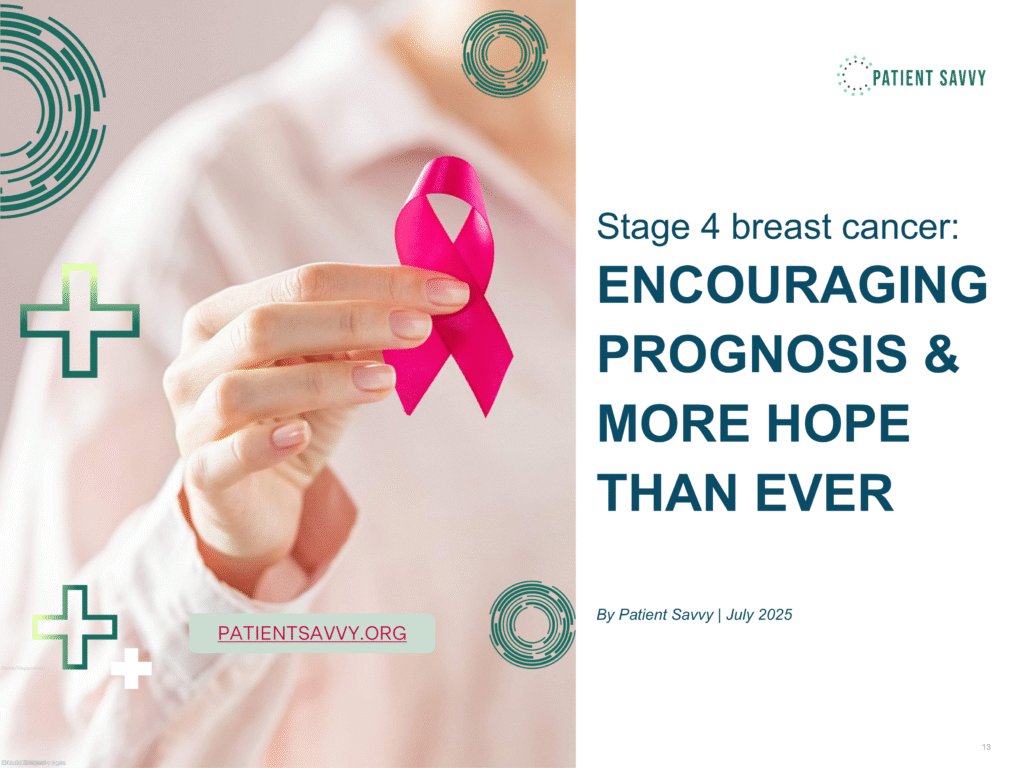A decade ago, only about 1 in 4 people diagnosed with stage 4 (metastatic) breast cancer in the United States were still alive five years later. Today it is roughly 1 in 3 overall—and close to 1 in 2 in several molecular sub‑groups—thanks to precision medicines, immunotherapy, and smarter supportive care. The gains are uneven but undeniably real, showing that the “average” statistics you see on most websites lag behind what many patients are actually experiencing right now.
Why the bleak headlines miss the full story
- Aggregated numbers hide fundamental differences. Stage 4 breast cancer is many diseases; its behavior depends on hormone receptors, HER2 status, tumor “immune‑hotness,” sites of spread, and even ethnicity, etc.
- Survival curves move slowly, but drug approvals move fast. Population registries e.g., SEER (Surveillance, Epidemiology, and End Results) and ACS (American Cancer Society) report in multi‑year blocks. As a result, a breakthrough approved in e.g., 2022, will not shift national five‑year survival statistics until 2027–‑2028.
- Small cohorts can point the way forward. Dozens of case series now show 40‑70 % five‑year survival in carefully selected patients—signals that the population data are starting to catch
The big picture: overall survival is climbing
| Cohort (U.S.) | Period of diagnosis | 5‑year relative survival, distant stage |
|---|---|---|
| ACS Facts & Figures 2013‑14 | 2002‑2008 | 23 % |
| ACS Facts & Figures 2024‑25 | 2014‑2020 | 32 % (all sub‑types combined) |
That ~40 % relative improvement translates into thousands of additional mothers, partners, and friends reaching the five‑year mark every year.
Sub‑type‑by‑sub‑type progress
Remember: these categories refer to the biology of the tumor, not the person.
Hormone‑receptor–positive / HER2‑negative (HR+/HER2‑)
What changed? The arrival of CDK4/6 inhibitors (palbociclib, ribociclib, abemaciclib) plus better endocrine therapy.
Numbers: A nationwide SEER analysis found a 10 % drop in breast‑cancer‑specific deaths after CDK4/6 inhibitors became standard (2015–2019 vs 2010–13)
Reality check for patients: Contemporary real‑world cohorts report ~38‑45 % five‑year survival when CDK4/6 inhibitors are started up front, compared with ~25 % a decade ago
HER2‑positive
What changed? Dual antibody blockade (trastuzumab + pertuzumab) followed by antibody‑drug conjugates (T‑DM1, T‑DXd).
Numbers: In the phase III DESTINY‑Breast03 trial, 67.6 % of patients were still alive at three years on trastuzumab‑deruxtecan after prior therapy. Real‑world Australian and French databases now report 40‑50 % five‑year survival for first‑line trastuzumab‑based regimens—double the rate seen in the 2000s
Why it matters: Many long‑term survivors resume full‑time work and parenting, something rarely possible 15 years ago.
Triple‑negative (TNBC)
What changed? Check‑point inhibitors (pembrolizumab, atezolizumab) plus sacituzumab‑govitecan and trastuzumab‑deruxtecan in “HER2‑low” TNBC.
Numbers: In PD‑L1–high tumors, pembrolizumab plus chemo cut the risk of death by 27 % and pushed median OS to 23 months (KEYNOTE‑355). Five‑year relative survival for metastatic TNBC remains low (~12‑15 %), but two‑year survival has nearly doubled in recent immunotherapy trials
Encouraging outliers: Case reports now document durable complete responses >5 years with combined immunotherapy / chemo
HER2‑low and other emerging niches
Roughly half of “HER2‑negative” cancers actually have enough HER2 protein to respond to T‑DXd. An early pooled analysis showed a 12‑month progression‑free survival of 13.2 months in heavily pre‑treated patients—numbers that would have been science fiction in 2010
Small but mighty studies: what they teach us
| Study | Size | Sub‑type | 5‑year OS or long‑term finding |
|---|---|---|---|
| Curie (France) real‑world HER2+ | 267 | HER2+ | 45 % five‑year OS |
| Long‑term non‑progression case series | 12 | Mixed | Patients disease‑free >5 years on modern therapy (no surgery) |
| DESTINY‑Breast03 | 524 | HER2+ | 77 % OS at 2 years; 67 % at 3 years on T‑DXd |
Why mention tiny cohorts?
- They flag what is biologically possible—and what the next wave of drugs might deliver to larger groups.
- They highlight exceptional responders whose tumors reveal new drug targets or immune pathways.
Five drivers of the survival surge
- Targeted therapy gets smarter – we now match drugs to estrogen, progesterone, HER2, PI3K, ESR1, and even “HER2‑low” signals.
- Immunotherapy cracks open TNBC – checkpoint inhibitors plus chemo turn a cold tumor “hot,” extending lives without adding cumulative toxicity.
- Drug‑conjugate technology – T‑DXd and sacituzumab deliver chemotherapy directly to cancer cells, sparing healthy tissues and pushing survival curves upward
- Continuous endocrine blockade – CDK4/6 inhibitors keep HR‑positive cancers under control for years while preserving quality of life.
- Earlier identification of metastases – widespread PET/CT and liquid biopsy detect limited‑volume disease that responds better to systemic therapy plus “metastasis‑directed” radiotherapy.
What the numbers don’t capture
- Quality of life: Modern regimens often avoid hair loss, preserve fertility options, and allow people to work or care for family.
- Equity gaps: Black and Indigenous women are still less likely to get diagnosed early and more likely to die, underlining the need for trial access and community outreach.
- Long‑term survivorship issues: Premature menopause, neuropathy, cardiac monitoring, and financial toxicity now matter because people are living long enough to face them.
Looking forward
Pipeline data presented at ASCO 2025 hint at sub‑50 % risk reductions in death for new combinations like CDK4/6 + PI3K inhibitors and T‑DXd plus immunotherapy, suggesting that today’s encouraging statistics will look conservative in another five years.
The bottom line
If you or a loved one hears the words “stage 4,” remember this: five‑year survival is no longer rare—and it is getting less rare every single year. The most important step you can take is to make sure your treatment plan reflects the current science, not the outdated averages that still haunt many internet pages.
Source: American Cancer Society; Susan G. Komen; American Cancer Society; ESMO OpenNature




I cringe at the use of ‘warrior’ and ‘fighting’ in reference to cancer, especially by those who do not have the condition but are attempting to be encouraging.. Warrior is not my view of myself. I prefer more peaceful references that encourage enjoying life, engaging in satisfying exercise or meditation.. I appreciate all done by the various groups, but just my opinion as a cancer patient.
Thank you so much for sharing your perspective with us. We completely understand that not everyone connects with words like “warrior” or “fighting,” and your point about focusing on peaceful encouragement is very meaningful. We’ll be more mindful in choosing language that resonates more personally with those living with cancer.